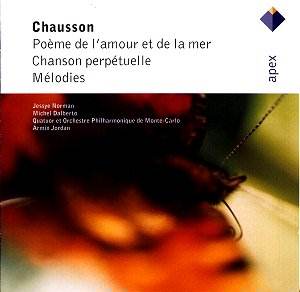Not so long ago I reviewed Hyperion’s complete edition
of Chausson’s mélodies (CDA67321/2) and felt it did a very useful
job, since it gathered together all his songs with piano (so of Poème
de l’amour et de la mer, the principal item here, it only has Le
temps de lilas, which also exists as a separate song with piano),
and very professionally too. The singers are Felicity Lott, Ann Murray
and Chris Pedro Trakas, the pianist Graham Johnson. But I was not the
only critic who remarked that the best individual Chausson performances
of the past had not been matched. I think most people had in mind historical
interpreters such as Maggie Teyte and Pierre Bernac rather than Jessye
Norman, whose French pronunciation is open to criticism. But as far
as I am concerned she belongs among the greats in most of the songs
in this programme.
Her sumptuous voice easily rides over the Wagnerian
writing of the orchestral cycle, but can also be fined down to a pianissimo.
With ideal support from Jordan this could hardly be bettered. If we
compare her Chanson perpétuelle with Murray’s, it could
be thought that the latter’s slightly faster tempo and understated style
are more "French", but in truth the sheer imagination with
which Norman and her partners bring every sultry phrase to life is another
world of interpretation. It is the same story for most of the mélodies
which close the recital, and in which Norman is truly fortunate in her
pianist; in Le Colibri and La dernière feuille their
slightly faster tempos avoid heaviness, and they are better at giving
formal shape to a song, rather than just letting it happen. Conversely,
their Sérénade italienne is slower than the Hyperion
one; at first I wasn’t sure if I liked it, but I was completely won
over by the last two pages where Dalberto’s pianism has a magic touch
which Johnson’s well-turned fingers do not match. Les Papillons
also wins thanks to Dalberto who goes beyond mere accuracy to give shape
and point to an accompaniment that can seem like a piano study. However,
the Schumannesque fantasy of Le Charme comes off better in Ann
Murray’s more measured performance.
In short, this is a super disc. But the notes are brief
and not especially helpful and there are no texts or translations. If
this does not worry you, then this is a Chausson collection for the
general listener, whereas the Hyperion is more specialised.
Christopher Howell


